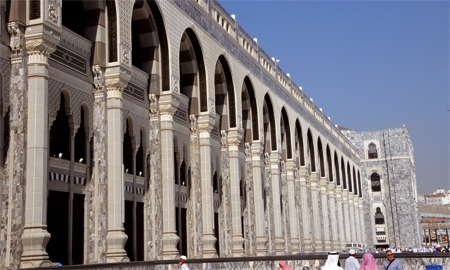
Whether worshippers are entering Al-Haram for the first time or have been attending it throughout their life, the sight of the Kaaba never fails to mesmerise the onlookers and captivate their soul. This simple yet glorious symbolic square structure covered with a black kiswah (curtain) made of the finest fabrics and hand embroidered with verses from the Quran using silver and gold-plated threads has a consoling and stirring effect on people. There is a general sense of serenity and peacefulness around Kaaba despite the hum surrounding it of the crowds reciting, praying, asking God for forgiveness and mercy.
Over the years the number of worshippers visiting the Holy Mosque has been increasing successively, especially during Ramadan and Hajj season. This increase in number has caused congestion and discomfort for the worshippers particularly on peak days, which led to the decision to enlarge Al-Massa’a in both horizontal and vertical directions in order to create more space for the worshippers to perform their Umrah and Hajj rituals with ease and comfort. Previous expansions of the Holy Mosque were of the tawaf area around the Kaaba and of the prayer area around that.
Design concept
The design concept depends on the enlargement of the present Massa’a from the eastern side by 20 metres to increase the overall width of Massa’a to 40 metres, as well as adding a new third floor so that the total area increases from 29,000m2 to become 72,000m2 with a total capacity of two and half times the old demolished Massa’a.
The design also provides Massa’a with passages in the upper first and second floors to be used by the handicapped and provides gathering spaces in the Safa and Marwa areas.
Furthermore, horizontal connecting passages for escalators and elevators are provided in addition to providing a basement with an area of 10,000m2.
The total surface building area for all floors of Al-Massa’a and services is estimated to be around 125,000m2 except the area of the top floor and the mechanical floor, which reaches 42,000m2.
Al-Massa’a is composed of three floors and four related areas for saa’i connected directly to the floors of the first Saudi extension of the Holy Mosque (ground floor, first floor, roof).
The new Massa’a roof floor has been raised higher than the Holy Mosque floors so it could be reached through escalators and elevators. Construction of the new basement under Al-Massa’a is to provide services and areas for handicapped worshippers and visitors.
Easy entrance to the Holy Mosque from the eastern piazza without passing through the ground floor is possible by means of electrical or fixed stairs.
The new design also provides three upper bridges to substitute the demolished bridges. It also has a passage for funerals from the basement of Al-Massa’a to the eastern piazza via suitable and convenient ramps.
The old minaret is being replaced with a new 99-metre-high minaret from the level of the outer piazza.
The expansion of the Al-Safa and Al-Marwah areas is being done in a suitable way to match the new horizontal and vertical expansion.
The escalator next to the Al-Safa and Al-Marwah areas will be removed and four new escalators will be reconstructed on the Al-Marwah side, which is used to evacuate Al-Massa’a after worshippers finish their saa’i.
Furthermore, the first Bakiyah from the first Saudi extension, which is attached to Al-Massa’a, will be removed and reconstructed again and the triangular concrete stairs near Al-Safa will also be removed.
Meanwhile, escalators at the Bab-Ajyad area, which leads to the Holy Mosque except the basement, will be added.
Architectural design
The external and internal elevations of Al-Massa’a are composed of integrated architectural elements used in the existing Holy Mosque, as well as some modifications due to the increase in the number of floors and the total changes and functions of the external walls of the building.
External elevations
The external elevations are designed to match the architectural style of the Holy Mosque. Additionally, the elevations are matched with the new height, which reaches 34 metres.
The arches for the elevations reach 27 metres high and 8 metres wide, which is twice the size of the arches used in the old Massa’a.
The elevations consist of units made of artificial stones and concrete in addition to using Wadi Fatemah marble and black marble, which is used in the Holy Mosque. All external columns are covered with Wadi Fatemah marble.
External mashrabia used in the elevations of Al-Massa’a are made of copper and steel, with an Islamic design similar to the existing units used in the Holy Mosque.
The Al-Safa dome is 32 metres in diameter and its height reaches 16.5 metres. The cladding of the Al-Safa dome is with golden mosaic units to match the existing domes.
As for the Al-Marwah dome, it has been enlarged and designed in a way to reach 35 metres in diameter and 34 metres in height.
Internal finishing
Saudi granite was used in the internal finishing, which is known for its quality, solidity and coloured decoration, matching the internal treatment for the elevations of Al-Massa’a.
The cladding of the internal walls is of granite and artificial stone decorating units similar to the existing cladding.
0 COMMENTS